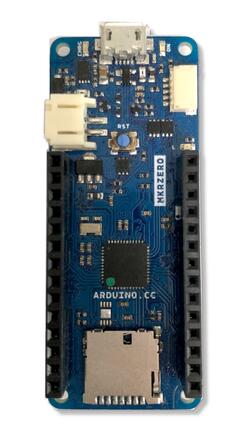Arduino MKR Zero
Overview
The Arduino MKR Zero built with smaller MKR form factor and powered by Atmel’s SAMD21 MCU. This board come with microSD card holder that allows you to play with music files with no extra hardware.

Hardware
ATSAMD21G18A ARM Cortex-M0+ processor at 48 MHz
32.768 kHz crystal oscillator
256 KiB flash memory and 32 KiB of RAM
One user LEDs
One reset button
microSD card slot
ATECC508A secure element
Supported Features
The arduino_mkrzero board configuration supports the following hardware features:
Interface |
Controller |
Driver/Component |
|---|---|---|
ADC |
on-chip |
Analog to digital converter |
COUNTER |
on-chip |
Pulse counter |
DMA |
on-chip |
Direct memory access unit |
Flash |
on-chip |
Can be used with LittleFS to store files |
GPIO |
on-chip |
I/O ports |
HWINFO |
on-chip |
Hardware info and serial number |
NVIC |
on-chip |
nested vector interrupt controller |
PWM |
on-chip |
Pulse Width Modulation |
SPI |
on-chip |
Serial Peripheral Interface ports |
I2C |
on-chip |
Inter-Integrated Circuit ports |
SYSTICK |
on-chip |
systick |
USART |
on-chip |
Serial ports |
USB |
on-chip |
USB device |
WDT |
on-chip |
Watchdog |
Other hardware features are not currently supported by Zephyr.
The default configuration can be found in the Kconfig boards/arduino/mkrzero/arduino_mkrzero_defconfig.
Connections and IOs
The Arduino store [1] has detailed information about board connections. Download the Arduino MKR Zero Schematic [2] for more detail.
System Clock
The SAMD21 MCU is configured to use the 32.768 kHz external oscillator with the on-chip PLL generating the 48 MHz system clock. The internal APB and GCLK unit are set up in the same way as the upstream Arduino libraries.
Serial Port
The SAMD21 MCU has 6 SERCOM based USARTs. SERCOM5 is available on pins 13(PA23) and 14(PA22).
PWM
The SAMD21 MCU has 3 TCC based PWM units with up to 4 outputs each and a period of 24 bits or 16 bits.
SPI Port
The SAMD21 MCU has 6 SERCOM based SPIs. On the Arduino MKR Zero, SERCOM1 is available on pin 8, 9, and 10. SERCOM2 connect to microSD card slot as SPI interface.
I2C Port
The SAMD21 MCU has 6 SERCOM based I2Cs. SERCOM0 is available on pin 11(PA08) and 12(PA09). This I2C bus also available as ESLOV(JST SH 5pin) socket. ATECC508A secure element is connect to this I2C bus.
USB Device Port
The SAMD21 MCU has a USB device port that can be used to communicate with a host PC. See the USB device support samples sample applications for more, such as the USB CDC-ACM sample which sets up a virtual serial port that echos characters back to the host PC.
DAC
The SAMD21 MCU has a single channel DAC with 10 bits of resolution. On the Arduino MKR Zero, the DAC is available on pin A0.
Programming and Debugging
The Arduino MKR Zero ships the BOSSA compatible bootloader. The bootloader can be entered by quickly tapping the reset button twice.
Flashing
Build the Zephyr kernel and the Hello World sample application:
west build -b arduino_mkrzero samples/hello_world
Connect the MKR Zero to your host computer using USB
Connect a 3.3 V USB to serial adapter to the board and to the host. See the Serial Port section above for the board’s pin connections.
Run your favorite terminal program to listen for output. Under Linux the terminal should be
/dev/ttyACM0. For example:$ minicom -D /dev/ttyACM0 -o
The -o option tells minicom not to send the modem initialization string. Connection should be configured as follows:
Speed: 115200
Data: 8 bits
Parity: None
Stop bits: 1
Tap the reset button twice quickly to enter bootloader mode
Flash the image:
west build -b arduino_mkrzero samples/hello_world west flash
You should see “Hello World! arduino_mkrzero” in your terminal.